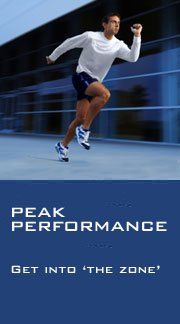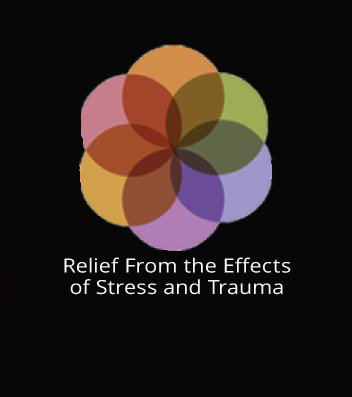Athlete
Athletes Peak Performance

Athletes can benefit for
Fight or Flight Therapy in two potentially dramatic ways:
• being more 'in the zone,' by becoming calmer, less stressed and more at ease during the stress of competition, and
• increased peripheral awareness, which allows for the processing of significantly more information, leading to more options and better decision making (for example, better 'court sense').
Being 'in the zone'
Competitive stress or 'nerves' can briefly enhance effort and creativity for some, but most people agree the more calm and centered they are, the better their performance. By definition, your baseline of calm is largely determined and limited by the chronic levels of fight-or-flight
in your nervous system.
Fight or Flight Therapy
resets your nervous system to a calmer place, giving you more ease, flexibility and resilience to better deal with the stress of performance or competition.
After completing Fight or Flight Therapy, many athletes report being 'in the zone' more often, where the ease and quality of their performance exceeds their expectations.
Improved peripheral awareness
To whatever degree your nervous system is stuck in fight-or-flight, by definition, your visual and mental world is narrowed (see: What is Fight-or-Flight?). At minimum, this limits your field of vision and the amount of information you can process, especially when under stress.
For team sports played on a court or rink, this is especially important.
Court Sense
'Court sense' is not only the awareness of where you are on the court, but also your teammates, your opponents, and a sense of the flow of action. The more visual information you can process, the broader your canvas and the greater your ability to anticipate, create and perform.
In basketball, the classic example is the point guard, Allen Iverson, who would dribble down court and only gave up the ball if he couldn't get off a good shot. As a classic 'shoot first' point guard, his visual and mental focus was primarily on himself and his own ability to score, far less on his teammates or the flow of play.
In contrast, many of us remember Magic Johnson who would dribble down court fully aware of where his teammates were and how the play was developing. He was looking for the most strategic place to pass the ball, and often made seemingly magical 'no look' passes, looking one way and throwing another, right on the money to a teammate for an easy basket.
It's not so much that A.I. was a selfish player, it's more likely that his visual world was a lot smaller than Magic's, simply because his nervous system was stuck in fight-or-flight. If A.I. had done Fight or Flight Therapy, it could have taken his game to a whole new level.
Racquet sports and volleyball
Consider the importance of a broader field of information in racquet sports like tennis, racquet ball or squash, where you're instructed to keep your eye on the ball when hitting. Imagine the strategic advantage of being able to focus intently on the ball, and still be keenly aware of where your opponent is positioning. It's significantly easier to win points when you know where your opponent is, and in particular, where he isn't.
This broader field of awareness is an asset in many sports, including hockey, soccer, volleyball, lacrosse and many others, even hitting a baseball.
Keep in mind
Unlike the other conditions listed on this website, in Peak Performance
we may not be looking to eliminate symptoms, as much as we are to enhance performance.
As such, people seeking Peak Performance
might have very few of the symptoms on the Fight or Flight Questionnaire. Their score could be very good and still benefit tremendously from Fight or Flight Therapy. They could gain that extra edge they need to raise their game to the next level.
Testimonials
Here are two very different examples of how Fight or Flight Therapy
improved athletic performance.
Peak Performance
A 62 year old drag racer came in seeking improved 'reaction time'. His concern was that he wasracing primarily against much younger drivers. He hoped there exercises, like hand/eye coordination exercises, that could speed up his ability to hit the accelerator at the start of a race.
Instead of devising 'foot/eye' reaction time exercises, I asked him if he thought it might be beneficial if he could be more relaxed and centered on the starting line. He said it would, and we evaluated him for Fight or Flight Therapy.
As one might expect, after six decades of life, just about everyone has experienced a significant amount of stress, if not trauma, in their life. Sure enough, we measured that his baseline of calm could be improved.
Within just the first month of his program he reported having an 'awesome' race. He was so calm at the start and throughout the race that upon finishing he felt compelled, before going back to the pits, to stop and journal his experience. Instead of the intensity he typically felt, he described how 'wonderful' it was being in 'the zone', where the entire race seemed to take place in slow motion.
Needless to say, we never got around to those 'eye/foot' exercises.
Peak Performance
"I've always been one of the best hitters on my team, but this year I couldn't hit a thing. I had 20/20 vision but Dr. Tessler found my (nervous system had shifted into fight-or-flight), possibly as a result of my parents' going through a divorce.
Now I hit better than ever. The baseball seems the size of a basketball!"
16 year old student athlete
The Fight or Flight
Questionaire
Is Flight or Flight Therapy right for you?
These area a sampling of symptoms common to people stuck in fight-or-flight.
How many symptoms do you have?
You might be surprised, or maybe you will confirm what you already suspect.
How many symptoms do you have?
You might be surprised, or maybe you will confirm what you already suspect.

